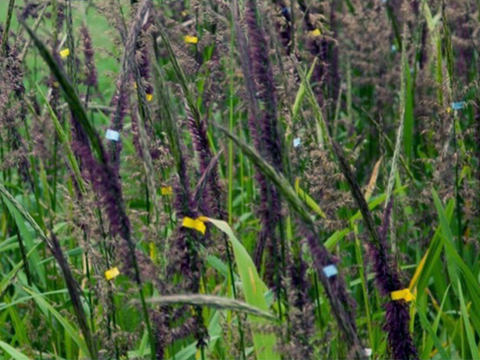Quick facts
- Incorporate nitrogen in both spring and fall to minimize N losses from flooding.
- To prevent phosphorus from entering drainage waters, incorporate P fertilizer and minimize erosion.
- Potassium at the levels applied to wild rice paddies is not an environmental concern.
- To avoid erosion of drainage ditches, release water slowly during a one-to-two-week period before harvest.
Nitrogen guidelines
Wild rice paddies are very different from upland fields. Nitrate-N build up in groundwater caused by over-fertilization is not a problem. Most N losses occur by the process of denitrification that produces N2, which makes up 78% of the atmosphere.
Dry urea, liquid ammonium fertilizers, or anhydrous ammonia are appropriate sources of N. Nitrate fertilizers are ineffective because of denitrification upon flooding.
Basal N is often applied in the fall. To maximize carryover of N to the following spring, follow basal N application by flooding within 2 or 3 days.
Fall flooding prevents oxidation of the ammonium forms of N to nitrate and the subsequent losses caused by denitrification when flooding occurs. If fall flooding is not possible, apply N when soil temperatures are well below 50ºF, preferably as close to freezing as possible.
You also can apply basal N in the spring immediately before flooding. Incorporate N in both spring and fall to minimize N losses.
For high yields, apply a minimum of one top-dress of 30-40 pounds per acre of N as urea, by aircraft. A second top-dress will maximize yields. You may need a third application if no basal N was applied or basal N was lost by nitrification followed by denitrification. Do not drain paddy water for about five days after N application.
Field test in mid-June for soil ammonium N to guide topdressing decisions. Use the SPAD chlorophyll meter or a color chart to help determine the timing and number of top-dress applications.
Nitrogen applications for wild rice production, based on soil type
| Type of soil | Amount N to apply |
|---|---|
| Organic soil | 25-40 lb. N/acre |
| Mineral soil | 70-100 lb. N/acre |
Phosphorus
Phosphorus in paddies can move into surface waters both in the soluble form and as part of soil particles by soil erosion. When phosphorus is surface-applied, it can dissolve in paddy waters causing algal blooms. To prevent phosphorus from entering drainage waters, incorporate P fertilizer and minimize erosion from ditches, etc.
Phosphorus can be applied in the fall or spring. It must be incorporated by plow down or injection. The rate of application should be determined by soil testing. When the Bray P 1 test exceeds 16 ppm, do not apply P. If it is not possible to incorporate P, it is best not to add any phosphorus fertilizer. The reserve phosphorus in the soil normally will be sufficient for good plant growth.
Phosphate fertilizer guidelines*
| Bray-P1 test results | 0-7 ppm | 8-15 ppm | 16+ ppm |
|---|---|---|---|
| Organic or Mineral soils | 40-50 lb./acre | 20-30 lb./acre | 0 lb./acre |
*Pounds of P2O5 suggested to apply per acre for wild rice production based on the Bray-P1 soil methods test reported in parts per million (ppm).
Potassium
Wild rice requires potassium both for high yield potential as well as helping protect against some diseases. Potassium at the levels applied to wild rice paddies is not an environmental concern.
Potassium can be applied in the fall or spring. Usually, it is applied with the phosphorus, but, unlike phosphorus, you must incorporate K. You can apply potassium with the top-dress N. This increases the late season uptake of K and might help prevent some diseases.
Potash fertilizer guidelines*
| Test results | 0-50 ppm | 51-100 ppm | 101-150 ppm | 151+ ppm |
|---|---|---|---|---|
| Organic soils | 120 lb./acre | 90 lb./acre | 40 lb./acre | 0 lb./acre |
| Mineral soils | 80 lb./acre | 50 lb./acre | 30 lb./acre | 0 lb./acre |
*Pounds of K2O suggested to apply per acre for wild rice production based on the ammonium acetate potassium test reported in parts per million (ppm).
Water drainage before harvest
Nitrogen in the water can be detected in wild rice fields for 3 to 5 days after fertilization, but at drainage time most nutrients in the water have been consumed by the plants.
To avoid erosion of drainage ditches, release the water slowly during a one-to-two-week period before harvest. The soil particles from erosion can carry phosphorus, in addition to any soluble P, into surface waters.
Drainage ditches should be stabilized with grasses if possible.
Reviewed in 2023


